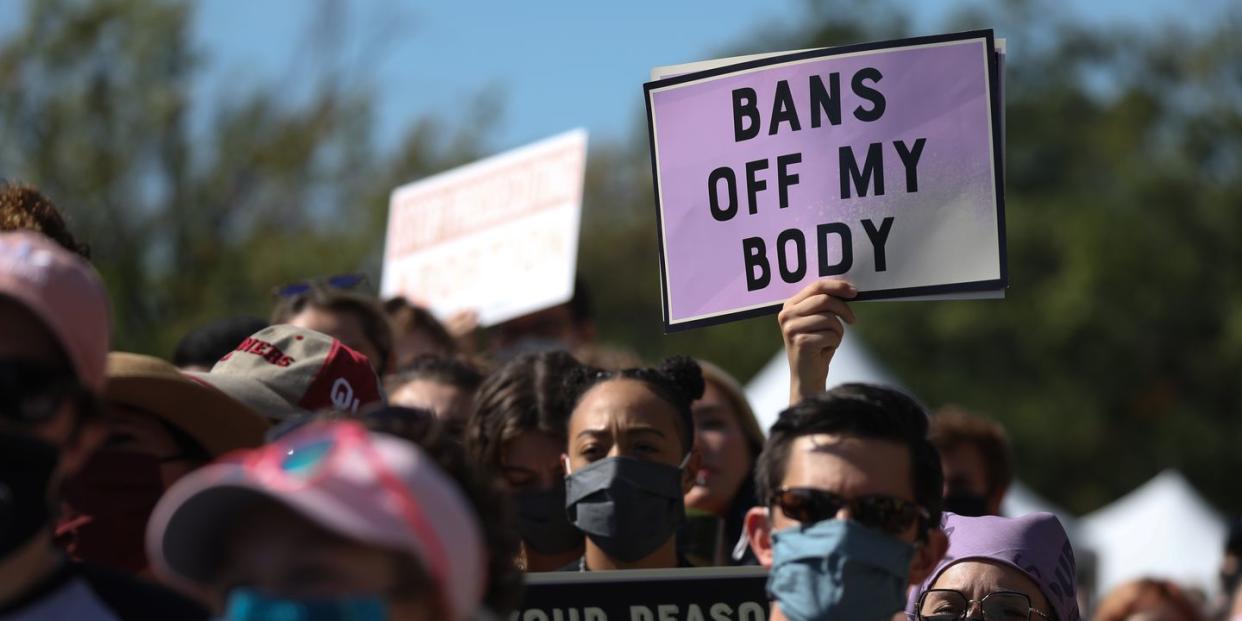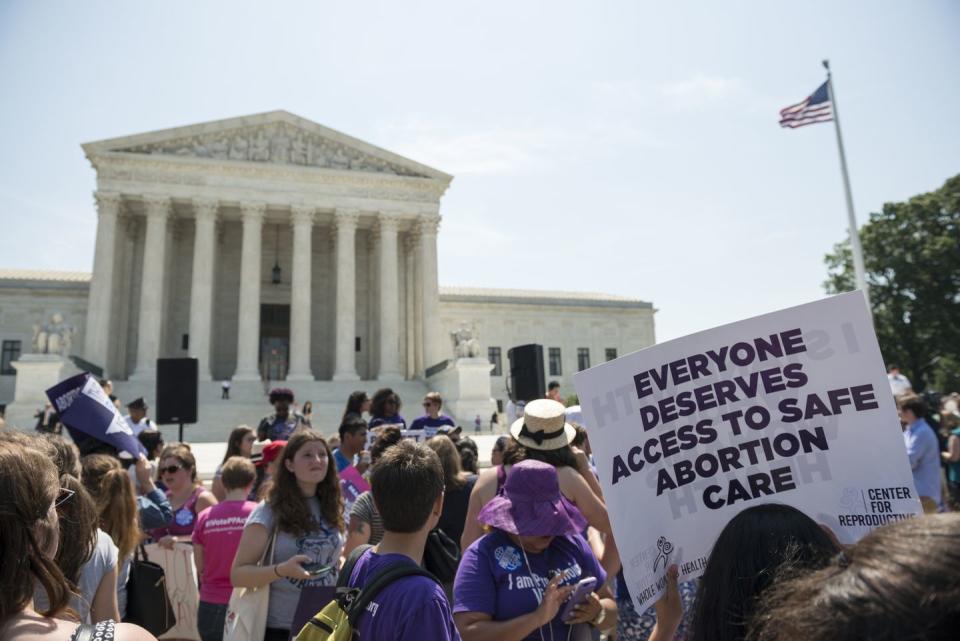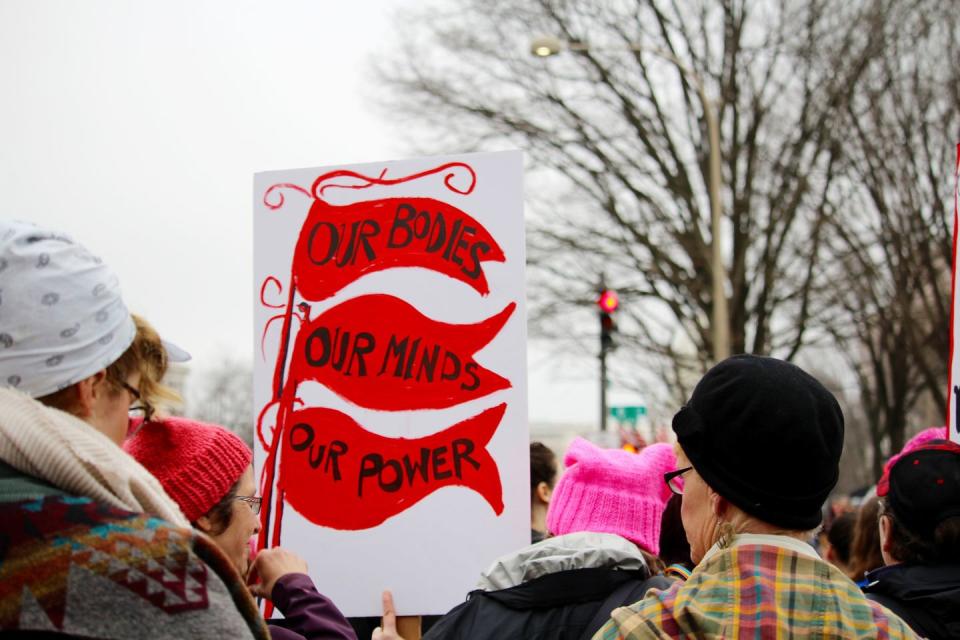Students Are Walking Out of Classrooms Nationwide on October 6 to Support Abortion and Transgender Rights

Protests calling for reproductive rights protection are happening across the country in response to the Supreme Court of the United States (SCOTUS) voting to reverse Roe v. Wade, the landmark 1973 decision that protects a person’s right to abortion access.
And as certain states proceed to eradicate reproductive rights after the overturning of Roe v. Wade, people are mobilizing together to show solidarity and support for safe, legal abortion access and to let their opinions and voices be heard.
There are numerous ways to protest this and other causes, but before you grab a sign and head out to join a march, prepare yourself on where to find a protest and how to protest safely. We asked advocacy group MoveOn’s Executive Director Rahna Epting to give her expertise on how to find a protest, what to bring, and most importantly, how to stay safe during a protest.
What should I bring to a protest?
“The most important things you can bring to a protest are your voice and your righteous indignation,” Epting explains. “You’re there to bring attention to a cause, so be loud, proud, and be visible!”
Oftentimes, people will express their opinion through creative signs, which is recommended. “Bold colors and short slogans that are easy to read and make your point clear are best,” she says.
To make sure you stay comfortable throughout the day (protests are typically at least a few hours long) you’ll want to bring water, snacks, and sunscreen to keep your skin protected in the outdoor elements. Comfortable clothing and shoes are a must as well, as you’ll often be standing or walking for long periods. So that means that a protest is not the time to try out a new pair of pants or break in a new set of shoes.
How can I protect my body during a protest?
Make sure to wear “clothing that covers your skin,” says Justin Mazzola, deputy director of research for Amnesty International. “This will protect you from not only the sun but also pepper spray exposure.”
While many protests are peaceful, in some cases, a protest may turn hostile and pepper spray or tear gas is used by an agitator or even law enforcement.
Pepper spray and tear gas mostly affects the eyes, nose, mouth, and throat and can cause difficulty breathing. Dr. Andrea Thau, Past President of the American Optometric Association says getting these substances in your eyes “can result in immediate swelling, uncontrollable tearing, redness, pain in the eyes, and even temporary loss of vision.”
She adds, “Pepper spray and tear gas can harm the corneas. The epithelial layer of the cornea is disrupted by pepper spray, so people with impaired corneal integrity (diabetes, dry eye, or recurrent corneal erosion) are particularly susceptible to these effects, compared to those with good eye health.”
So what should you do if you get pepper spray or tear gas in your eyes? “Do not rub your eyes; pepper spray is oil-based and touching or rubbing your eyes can spread the oil and make the pain and irritation worse. Instead, blink to help flush the eyes and immediately rinse them out with eyewash or water from a clean container for at least 15 minutes.”
“If you are wearing contact lenses, immediately remove them before flushing the eye. Do not try to neutralize the chemical with other substances and do not bandage the eye,” Dr. Thau says. “Seek immediate medical attention after flushing out your eyes to rule out any potential damage that may not be obvious to the naked eye.”
While there is a myth that contacts shouldn't be worn at a protest as it can worsen the effects of pepper spray and tear gas, Dr. Thau says it’s simply not true. “There is no evidence that wearing contact lenses increases the risk of eye injury. However, I do recommend wearing proper eye protection over contact lenses such as shatter-resistant safety glasses, non-prescription goggles, or face shields. Contact lenses would be preferred in this instance over eyeglasses since they can improve the fit and comfort of eye safety equipment, such as goggles and full-face respirators.”
“Additionally, individuals who wear contact lenses usually have a wider field of vision than with eyeglasses. They also often have less visual distortion, especially with higher power lens prescriptions,” she says, reminding us that, “While goggles and other eye protection may help avoid some level of exposure to pepper spray and tear gas, they do not provide 100 percent protection.”
Are there any long-term risks or complications associated with eyes coming into contact with pepper spray or tear gas? Dr. Thau says that there is no scientific evidence to suggest that pepper spray causes permanent damage to the eye, however, “Repeated exposure could cause significant and permanent damage to the cornea.”
Tear gas is a bit of a different situation. Dr. Thau says, “Tear gas can penetrate the deeper tissues in the eyes and may lead to more serious eye injuries, including hyphema, cataracts, uveitis, necrotizing keratitis, secondary glaucoma, traumatic optic neuropathy, and loss of sight.”
So in other words, protect your eyes while at a protest as you never know what airborne substances you could be exposed to that can harm your vision — temporarily or permanently. For more information on eye health and vision, and to find a local AOA doctor of optometry, visit www.aoa.org.
How can you protest peacefully?

MoveOn shared several safe protesting best practices, which Epting reiterates to Seventeen: “Be courteous, be kind, and be mindful of your surroundings,” Epting says. “Most people at a protest are there for the right reasons, but you may encounter counter-protesters or agitators attempting to instigate a confrontation.”
If you happen to encounter a hostile agitator, Epting via MoveOn advises that you “stay calm, don’t argue or engage with them,” and instead, “start a chant about the issue and get fellow protesters to join in to drown them out, and move away from the person causing trouble.” Many protests will have designated marshalls trained to de-escalate conflicts, so be on the lookout for them if you encounter this type of scenario. Don’t be afraid to ask for help!
Finally, if you’re not personally connected to the cause that you are marching in support of, remember to be a good ally and check your privilege throughout the protest. If relevant, “Let BIPOC (Black, Indigenous, and people of color) and the people directly impacted by the issue lead and center their voices and experiences.”
So for example, if you are at a reproductive rights protest, it is important that groups most affected by the threat of not having reproductive rights protections be given the space to express themselves. For more tips on how to be an ally while protesting, visit this Twitter thread made by MoveOn.
How can I find a protest near me?
Kudos for wanting to get involved, as change is made by people lifting their voices locally. The easiest way to stay in the loop about events happening near you is to find and follow organizations you care about on social media to see if they have any upcoming marches planned.
“Social media is also a great resource to look for actions in your community. Try searching the hashtag for a cause such as #BansOffOurBodies on social media or google “Bans Off Our Bodies + [your city].”
On October 6, students at colleges, universities, and high schools nationwide are walking out of classrooms for the Day of Student Action for Reproductive Justice, organized by the Graduate Student Action Network (GSAN) and the Young Democratic Socialists of America (YDSA). The protest, which will take place at over 50 institutions, is to fight for safe, legal abortion and contraceptive access, gender-affirming healthcare, and comprehensive sex education. Organizers call for students to skip class, and instead, participate in campus events such as rallies, marches, petition distribution, and voter registration drives. Participating colleges include Arizona State University, Caltech, University of Florida, University of Maryland, New York University, University of Oregon, Texas State University, University of Missouri, and many more in 29 states. You can find a full list (and join the protest!) here.
What are my constitutional rights as a protester?

“The ACLU (The American Civil Liberties Union) has an excellent list of protesters’ rights, that covers your rights both as an organizer of a protest and as an attendee, and also has critical information on what to do if you’re stopped by police at a protest,” Epting says.
If you want to give yourself a deep refresh, take a look at the U.S. Constitution which protects protestors in many ways. Some important callouts include the First Amendment, which allows for freedom of speech and the ability to protest, and the Fourth Amendment, which prohibits unlawful search or seizure of an individual or their private property without a search warrant.
What should I do and what should I not do at a protest?
Ahead, MoveOn compiled a useful list of what to do and what not to do at a protest.
Do:
Vet the action you plan to attend. Who’s it organized by? Where’s the action, what’s the route?
Chant loudly and proudly, wear clothing in support of a cause, and wave your sign!
De-escalate potential conflict. Move away, disengage, and lead those around you away from counter-protestors or agitators.
Remain aware of where law enforcement is located and how they’re interacting with protesters. You have a legal right to peacefully protest as well as to record police from a distance.
Go with a group or friend. Know who your people are. Establish ways to identify/communicate with one another. Exchange important info like legal name, DOB, phone number, and address to locate one another if someone is arrested or otherwise separated from the group.
Don’t:
Incite violence or engage with anyone acting in a violent or confrontational manner against protesters. The violence that does ensue oftentimes disproportionately impacts and is directed at Black people and people of color. Be mindful that you’re not inadvertently placing others in harm’s way.
Police other protesters. Recognize that people grieve in their own way. We’re not there to define what is or isn’t an appropriate way for impacted communities to respond to injustice. Give people the space to be angry, sad, and even joyful. Distance yourself if the actions of an individual or group make you feel uncomfortable or unsafe.
Feel like you have to answer questions from the media that are at the event —redirect the press to connect with the protest leaders for their interview requests.
For more information on national mobilizations that MoveOn is involved in, please visit www.moveon.org.
You Might Also Like

